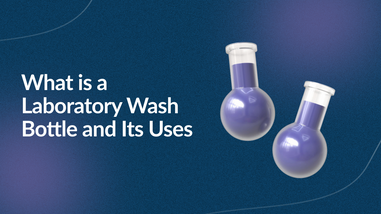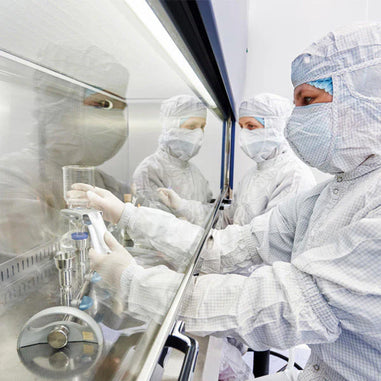- No products in the cart.
It doesn’t matter how careful you are in a lab, accidents still happen. That’s why it’s essential to have written procedures in place that will give you some direction in how to minimize the risk once a spill occurs.
When accidents occur unexpectedly, sometimes it’s hard to think and react quickly. That’s why having standard written procedures on hand is so important. You can just follow those step-by-step without any forethought which initiates a quicker response and minimizes any further damage or risk.
Here, we’ll cover how to evaluate and safely handle hazardous chemical spill containment.
What Is a Hazardous Chemical?
A hazardous chemical is a compound or substance that has the potential to harm humans, animals, the environment, and damage property. It can present itself as dust, a vapor, smoke, fumes, a mixture, a solvent, a catalyst, cleaning agent, an acid, or as alkali.

Hazardous chemicals fall into one of three categories. These include flammable or explosive, an irritant or corrosive to eyes, lungs, and skin, or as toxic chemicals.
Due to the potential risk, hazardous chemicals must be handled with extreme caution when storing, transporting, or using to prevent any kind of leakage or spillage. You should always wear protective clothing and PPE or personal protective equipment to protect yourself from any unintended contact.
The personal protective equipment that should be worn will depend on the chemical. These might include safety goggles, rubber gloves, chemical-resistant coveralls, or even respirators.
Hazardous chemicals come with Safety Data Sheets that explain the severity of the risk and the safety measures that should be in place when handling these chemicals.
What is a Spill Containment System?
A spill containment system is a process that prevents hazardous chemicals from being absorbed, having contact with, or flowing into undesired or unintended areas.
Typically, the containment system depends on the type of chemical involved, the characteristics of the primary container, the facility where the spill or leak originated from, the equipment involved, and the immediate area.
The goal of the system is to keep the spillage within a barrier to prevent it from spreading. The standard for chemical containment is secondary containment which acts as a backup if the primary containment fails.
What is Important for Spill Containment?
There are several important things to keep in mind when it comes to spill prevention and containment. Chemicals should be stored properly and accurately labeled. All containers intended for use with hazardous chemicals should be inspected regularly to ensure that there are no cracks where leakage could occur.
Those handling hazardous chemicals should be well-trained on the properties of the chemicals, how to store the chemicals, what PPE to wear, how to effectively handle spills, and on clean-up procedures.
It’s extremely important to have preventive measures spelled out and easily accessible, as well as emergency handling procedures. As a reference for these procedures, make sure to stay on top of and remain compliant with the guidelines set forth by the EPA and OSHA.
How Should You Respond to a Hazardous Chemical Spill?
The following are general hazardous chemical spill response procedures:
- The first thing is to evaluate the spill. What is the immediate danger? Is it a fire, explosion, exposure, etc.? Do you need to quickly evacuate?
- Seek emergency medical help for anyone in the lab if needed.
- Follow all emergency handling procedures and call for help if needed. In the meantime, confine the area by closing the doors, covering all drains, and isolating any contaminated individual.
- Report the spill to the proper emergency response team including information on injured staff, the type of chemical spilled, an estimate of the quantity, and the location.
- Secure the area until the emergency personnel respond to prevent anyone from entering the spilled area.
- Trained personnel should clean up the area by wearing PPE. If the cleanup is beyond your comfort level, call the appropriate response team.
Hazardous Chemical Spill Containment Product Essentials
The following are some essential products to have on hand in case of a hazardous chemical spill:
- PLR222 - PIG® Build-A-Berm® Barrier Kit . This kit is ideal for long-term custom containment.
- PLR212 - PIG® SpillBlocker® Dike. This dike is ideal for small spills.
- PAK210 - PIG® 4-Drum Poly Spill Containment Pallet
- PLR283 - PIG® Drive-Over Build-A-Berm® Barrier Straight Section. This section is ideal for long-term custom containment and high-traffic areas.
- PAK601 - PIG® Roll Top Hardcover Spill Pallet
PAK792 - PIG® Collapse-A-Tainer® Spill Containment Berm. This containment berm is ideal for small equipment & drums and drive-in access.
Where To Buy Hazardous Chemical Spill Containment Products
Lab Pro offers a large variety of hazardous chemical spill containment products. For over 40 years, Lab Pro Inc. has been committed to delivering the highest quality medical tools, chemicals, lab equipment, distance learning kits, lab supplies, and cleanroom PPE apparel to medical device companies and laboratories worldwide. To learn more, visit the biggest Lab Supply showroom in California, or contact us online or at 888-452-2776.












































